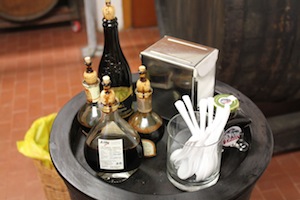Have you ever tried to choose balsamic vinegar and being overwhelmed by the variety of choices and lack of information?
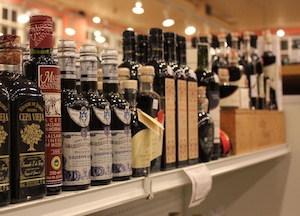 Well, it happened to me far too many times. I have been looking at reasonable priced products versus very expensive ones without knowing if the cost was worth it or not; fancy bottles and more anonymous ones; small quantities or large; aged balsamic and new. And the choice would not be any easier in an Italian store…
Well, it happened to me far too many times. I have been looking at reasonable priced products versus very expensive ones without knowing if the cost was worth it or not; fancy bottles and more anonymous ones; small quantities or large; aged balsamic and new. And the choice would not be any easier in an Italian store…
So this is why on a snowy day last December – with my apprehensive mom screaming at the back that it was icy, and I would have killed myself driving there – I decided to go to Modena, one and half hour from my hometown, and meet a traditional balsamic producer to finally unveil the mystery.
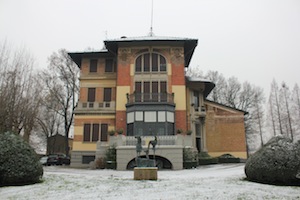
I wanted to go for the excellence, and the choice fell upon Acetaia S. Donnino, a destination suggested by the Consorzio Produttori Antiche Acetaie: a traditional acetaia set in a beautiful villa with park, right outside Modena city.
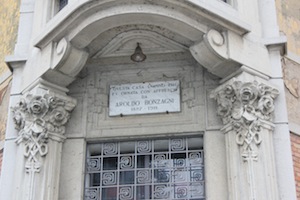
The 1910 villa is amazing, a gastronomic destination for balsamic lovers that with its tours entertains something like 9,000 visitors a year. It is a Liberty and Art Nouveu style icon, with frescos and paintings from Aroldo Bonzagni – avant-garde artist from Cento, Ferrara, signer of the first Futurist Manifesto in 1910, friend of Umberto Boccioni and Carlo Carrà. The house was also used as stage for scenes from Bernardo Bertolucci’s movie “Novecento,” starred by Robert de Niro and Gérard Depardieu.
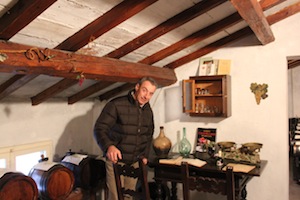
The owner, Davide Leonelli Lonardi, explained me that the family acquired the villa right after World War II, in 1947, and discovered two old “batterie” (series of barrels) at least 50 years old, in the attic. The place had been robbed by Nazis occupying the villa during the war, but the old barrels were still there – maybe because the Germans didn’t know what to do with it. And this is how the family’s balsamic production began, adding new batterie – with the century old ones still being in production. Nowadays the Acetaia makes over 2,000 bottles of traditional balsamic vinegar, about 40% of them are labeled 25 years old or older.
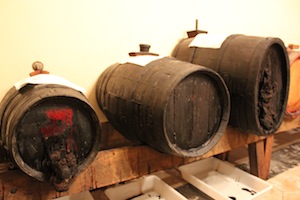 “In fact” – Mr. Lonardi explained – “even if the barrels may be something like 100 years old, traditional Balsamic Vinegar sealed with the European label DOP (DPO in English – Protected Designation of Origin), can only belong to two categories: 12 years old or older, and 25 years old or older.” Anything older, I later discovered after a conversation with Carlo Ferretti, from the Consorzio Tutela Aceto Balsamico Tradizionale di Reggio Emilia, is in fact similar in taste, so that a further classification is not considered necessary.
“In fact” – Mr. Lonardi explained – “even if the barrels may be something like 100 years old, traditional Balsamic Vinegar sealed with the European label DOP (DPO in English – Protected Designation of Origin), can only belong to two categories: 12 years old or older, and 25 years old or older.” Anything older, I later discovered after a conversation with Carlo Ferretti, from the Consorzio Tutela Aceto Balsamico Tradizionale di Reggio Emilia, is in fact similar in taste, so that a further classification is not considered necessary.
(First note to self: do not go for a hundred-years-old fancy balsamic, because it doesn’t make a lot of sense. 25 years is plenty!)
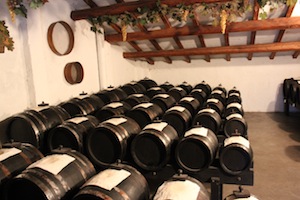 More, the aging time of balsamic vinegar is a blurry concept: it happens in a batteria (series of 5-6 barrels of decreasing size and made of different wood scents) with a method named rincalzo, or “topping up,” where a portion of the balsamic vinegar is in fact refilled each year. Once a year, usually in the coldest months, about 10 percent of balsamic vinegar is extracted from the smallest barrel, and is ready to be bottled and sold. This extract is replaced by the same quantity of balsamic aging in the immediately bigger barrel. That second barrel will be refilled by liquid coming from the next biggest barrel, and so on for all the barrels, from the smallest to the biggest. The largest barrel is then replenished with previously stored reduced must obtained by filtering and cooking fresh grape juice for hours, until it is reduced by at least a third.
More, the aging time of balsamic vinegar is a blurry concept: it happens in a batteria (series of 5-6 barrels of decreasing size and made of different wood scents) with a method named rincalzo, or “topping up,” where a portion of the balsamic vinegar is in fact refilled each year. Once a year, usually in the coldest months, about 10 percent of balsamic vinegar is extracted from the smallest barrel, and is ready to be bottled and sold. This extract is replaced by the same quantity of balsamic aging in the immediately bigger barrel. That second barrel will be refilled by liquid coming from the next biggest barrel, and so on for all the barrels, from the smallest to the biggest. The largest barrel is then replenished with previously stored reduced must obtained by filtering and cooking fresh grape juice for hours, until it is reduced by at least a third.
That is why when measuring the aging of the balsamic vinegar, what what really counts is then when the “batteria” was started, the age of the yeast and bacteria inside the barrels, how they evolve and provide a complex aroma to the balsamic vinegar.
Also, curiously, unlike wine, balsamic vinegar is aged in … attics.
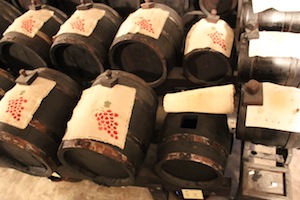 Balsamic production requires an environment where hot, dry summers are followed by humid and cold winters. The fluctuation of temperatures must be dramatic in order for the balsamic vinegar to properly mature. The environment plays a fundamental role, and vinegar should also be in contact with air and be able to evaporate. This is also why the barrels, made of various woods to impart different flavors (oak, chestnut, juniper or mulberry, cherry, fraxinus, acacia), are opened at the top.
Balsamic production requires an environment where hot, dry summers are followed by humid and cold winters. The fluctuation of temperatures must be dramatic in order for the balsamic vinegar to properly mature. The environment plays a fundamental role, and vinegar should also be in contact with air and be able to evaporate. This is also why the barrels, made of various woods to impart different flavors (oak, chestnut, juniper or mulberry, cherry, fraxinus, acacia), are opened at the top.
Villa San Donnino has several “batterie” very neatly displayed in rows. Mr. Lonardi even takes care of a “batteria” that belongs to a local family, a present the parents decided to give to their newborn daughter: the precious condiment will be ready when she will be an adult. This fascinating tradition dates back from the medieval age, when balsamic was part of the family legacy, mentioned in testaments, and a valued dowry of wealthy brides.
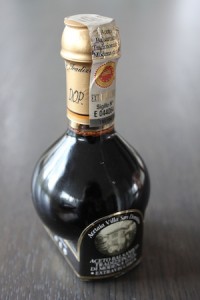 Balsamic vinegar has in fact been around for centuries, since the Roman times when it was called “Saba”. All “traditional” balsamic vinegars has been produced following this production process for centuries, but to be labeled as DOP, balsamic vinegar undergo a detailed scrutiny by the Consortiums (two in Modena, one in Reggio-Emilia). The consortiums control the only ingredient allowed (juice coming from specific certified DOC local grapes grown in the province of Modena or Reggio Emilia) and production process; they also screen with blind-test the finish product and package directly into specific bottles: a bell shaped one for the Reggio Emilia DOP balsamic, spherical with a rectangular shape, designed by Giugiaro’s design, for the Modena’s DOP.
Balsamic vinegar has in fact been around for centuries, since the Roman times when it was called “Saba”. All “traditional” balsamic vinegars has been produced following this production process for centuries, but to be labeled as DOP, balsamic vinegar undergo a detailed scrutiny by the Consortiums (two in Modena, one in Reggio-Emilia). The consortiums control the only ingredient allowed (juice coming from specific certified DOC local grapes grown in the province of Modena or Reggio Emilia) and production process; they also screen with blind-test the finish product and package directly into specific bottles: a bell shaped one for the Reggio Emilia DOP balsamic, spherical with a rectangular shape, designed by Giugiaro’s design, for the Modena’s DOP.
The visit, at Villa Donnino, ends with a tasting of different products: the “Nerone”, a dressing produced by Mr. Lonardi similar to the balsamic vinegar but aged only six years, a 12 years old or older DOP and a 25 years old or older DOP: a crescendo of intense, deeply aromatic, graceful sweet and sour flavor. The oldest DOP in particular is truly rich and luscious.
For those who have never tasted it, DOP is expensive and difficult to find, and a very different balsamic from the far more ubiquitous products that you can usually buy in supermarkets.In store, you can usually find IGP (Or PGI, Protected Geographical Indication) balsamic vinegars, also awarded with a European seal, but they are made from a blend of cooked must and fresh vinegar (sometimes caramel), usually aged just a few months (only the “invecchiato” label means that it is aged three or more years).
Both IGP and DOP balsamic vinegars are dark-brown and syrupy, but the DOP is sweeter and way less acidic than the IGP vinegar. It has a deeper, more complex flavor and a much denser, velvety consistency, with aromas reminiscent of the different wood barrels used during the long aging process. It is generally used “a crudo”, as finish touch to dishes, only on special occasions as a dressing for very sophisticated salads, almost never as an ingredient while cooking a recipe.
In stores, you will also find a lot of balsamic products that are not labeled either with IGP or DOP seals. The European law establishes that those food specialties cannot be named “balsamic vinegar”. They can only be called balsamic “dressing” or “condiment” or something similar. These are products that are special creations from producers, and are made outside set protocols.
Still overwhelmed? When it gets slippery, go for either a IGP or DOP balsamic: they are the only products that offer certified quality since they are ruled and controlled by European law.
Stay tuned for a future posting about uses and recipes of these two very different products!

